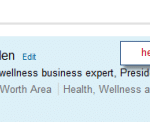Developing a Google Ads strategy for a small health, fitness, or wellness business is, at least theoretically, a good way to make money. In the spirit of transparency, that’s one of the reasons Radial exists.
If you’re doing ethical work, you’re helping your clients get the word out about their business and targeting people who already searching online for businesses like theirs. It’s a win-win. Everybody’s happy.
The problems usually start when your Google Ads contractor starts acting unethically or incompetently, or just stops caring and starts mailing it in.
1. Using “fake” conversions to make your ad metrics look good
In sales, a “conversion” generally refers to an event that signifies purchase intent. That conversion may happen at the moment of purchase, or it may simply be the earliest reliable indication that someone will eventually become a customer.
Sometimes it’s hard to measure conversions if the actual act of becoming a customer doesn’t happen immediately online: for instance, checking out items in a shopping cart. That’s when marketers resort to other ways of measuring conversions that tell you when someone is probably going to become a customer: for instance, scheduling a facilities tour, making a phone call to ask those last few questions, clicking on “Maps and Directions”, or filling out a form online that asks them for a lot of personal info they wouldn’t otherwise disclose unless they intended to become a member. Anyone who doesn’t really intend to buy will simply walk away. And you want them to! That’s called “lead qualification.”
Pre-sales activities can be a reliable indicator of conversions as long as you have a good idea what percentage of them actually will become customers.
For simplicity’s sake, Let’s suppose it doesn’t actually cost you anything to advertise. If 80% of the folks you think are going to become customers actually do, and your average new sign-up brings you $100, then each prospect “conversion” is worth $80.
But if only 5% of your prospects are becoming customers and each buy is worth the same $100, the average value of each prospect is just $5. Chances are really good that no matter how many customers you manage to enroll, it costs you more than $5 per prospect to find them. Miscounting conversions leads you to send good money after bad. You find yourself chasing leads that never pan out and you bleed money.
That’s why it’s important that you don’t count casual “drive-by” web visits as real conversions. Those people are unlikely to become customers, so you don’t want to pay Google for sending them your way.
The types of activities most likely to be real conversions are those that are clear signs of buying:
- Actually purchasing a membership online
- Calling the business to ask about pricing options, tours, membership levels, etc.
- Getting directions to your location, ask a few questions, and pick up that 3-day pass
- Downloading a membership fact sheet
- Even visiting a pricing comparison page on your website
What should not count as a conversion:
- A visit to any page on your website–doesn’t matter which, with no behavior even indicating interest
- A visit to your home page
- A phone call that lasts less than 30 seconds (this is typically an inquiry about hours of business or something NOT related to a purchase decision involving questions)
If you’re paying for “conversions” that represent no actual intent to buy, you’re basically paying real money for fake customers.
Just last week, we spoke with a client who was shocked when we told them that their Google Ads conversions weren’t set up right. They explained that their contractor showed them a conversion rate close to 90%, but somehow they didn’t see any customers walking through the door.
The problem? None of those people actually bought anything. But their Google Ads contractor was counting them as potential customers and driving Google to spend their ad budget in unproductive ways doubling down on those non-customers.
Google rated their ad quality as “poor” because the keywords they were bidding on didn’t appear in their ads OR on the website, meaning that the client had to pay a higher price for visible placement of the ads.
Several ads had been shut down for Policy Violations, including dubious medical claims, appearing to sell certain pharmaceuticals, and off-site redirects, which often put the client in “Google Ads jail.” Many of their ads also used a deprecated format that disallowed edits, so none of the broken ads could be fixed. Unfortunately, the mere PRESENCE of broken or deprecated ads, running or not, can affect how Google’s algorithm scores ad quality. Impressions, clicks, and conversions go down because the ads rarely run.
Instead of fixing or replacing the broken ads, their Ads contractor set up every remaining Google ad to “convert” when any page on the website was visited. Since their keyword bidding strategy was set to “maximize conversions”, Google bid accordingly to maximize these worthless “conversions.”
Their advertising strategy was literally bleeding them financially dry before they found us.
Those so-called conversions were never conversions in the first place. Representing things as otherwise was flat-out dishonest, lazy, incompetent, or perhaps all three.
Make sure your Google Ads agency or contractor isn’t doing this, because fake conversions can make you think you’re winning customers when you’re losing money.
2. Matching ads to content just for the sake of matching
One of the things that Google does is to compute a quality score for your ads by judging how well the keywords in your ads match those used on the web pages your ads direct people to. In fact, Google calls the pages that the ads direct people to “landing pages”, because they’re not just there to welcome people to Busta’s Body Barn, but to deliver on the promise the ads talk about.
If your business is a no-nonsense strongman gym with Atlas stones, carry racks and tire flips and your ads say the same thing, generally your ads get a higher quality score if they contain headline copy like “Top-Rated Strongman Gym in Plano TX” and description copy like “Atlas stones, carry racks, tire flips.”
But this practice can be taken to an extreme. Some people fill up Google Ads landing pages with keywords and not much else. There’s nothing about testimonials, the customer experience, your mission, how long you’ve been in business. The pages look artificial and sound AI-generated. They look like link farms and not real sites.
Sure, the keywords in their ads match the keywords on the website…but that’s all. That strategy might have worked in the old days. But it hasn’t been like that in a long time. Google’s AI checks the readability, navigability, and overall visitor experience when it test-visits your ads’ landing pages. If those are poor, you’ll still get a low quality score.
Ads with low quality scores will cost you MUCH more to run. And that’s money you could have spent attracting good prospects by providing useful information.
Every serious prospect has 7 critical questions they want answered before they become a customer. If your landing pages don’t address them, whatever you paid for isn’t actually closing business.
If your landing page copy does nothing but repeat what the ads say, then they’re not closing business, and it’s time to fire your Google Ads contractor, because they either don’t know what they’re doing or don’t care. Tell them you’re doing a security audit, reset your website password, and get far, far away from the train wreck they’re sending you into.
3. Using the same text in the headlines and descriptions
Just to set the record straight, your Google Ads headlines should be consistent with the description lines in your ads. But using the same text not only lazy–it makes the ads look bad. Do you REALLY want an ad that says:
Buff Bob’s No-Nonsense Gym
Buff Bob’s No-Nonsense Gym
Yeah, we didn’t really think so. MOST people would want to see more about Buff Bob’s No-Nonsense Gym in the description than just the name again. For instance, info about additional services that match likely search terms for which Buff Bob’s would be a good match.
So why are you letting your Google Ads contractor mail it in and charge you for this?
4. Manually managing stuff Google does automatically
Like specifying every single zip code within a 25-mile drive-time radius of the business.
Unless the neighborhood changes DRASTICALLY once you get to the other side of the highway, you’re probably okay with a radius-based plan, or in smaller locations, the whole town. You can even target multiple locations this way: for instance, if you want to target the affluent suburbs north and west of Chicago, but not the entire 9000 square miles and all 14 counties.
These days, Google Ads can do a lot automatically. For instance, you can set up not just drive-time radius but Dynamic Ads that let Google pick from a list of potential Headlines and a list of potential Descriptions and arrange them into whatever ads convert the most. Combine that with the use of variable-valued fields in ad copy, careful use of automatically-suggested keywords, and automated conversion-based bidding, and your ads can do a lot for you without much effort on your part.
We’ve actually seen inept Google Ads contractors work AROUND that. They’ve created dozens and dozens of manually-configured ads and ad groups that differ only in which headline variant they use. Then these same contractors manually set up budgets and keyword bids for these basically identical ad groups, which causes them to bid against each other and drive up costs as if your other ad groups were actually your competitors. And we’ve seen Google Ads contractors set up identical ad groups that differ only in zip code…and there’s not even any difference in demographics between any of the zip codes.
Again, and if you’re seeing a pattern here it’s because there is one. Letting your Google Ads contractor manually set up what’s ALREADY automated in Google is costing you money–twice. Once for the inefficient ads, and a SECOND time for the contractor to overbill you for setting something up manually that Google can do automatically–AND which somehow magically seems to require their regular intervention to “maintain.” The only purpose such manual intervention serves is to increase the number of billable hours your contractor charges you for.
5. Not separating “brand search” ads from other ads
“Brand search” is a term used to refer to searches for your actual business name: for instance, “Bob’s Buff Barn.” It’s different from a search for “strongman gyms near me” because the searcher already knows very specifically what they’re looking for.
Generally speaking, the more specific the search and the better your keywords match, the less it costs you to run ads.
But not if your brand search ads are in the same Ad Group and use the same keywords as your more generic ads.
Why? Because your ads for “Bob’s Buff Barn – Top-Rated Strongman Gym in Cleveland” use the same keywords and budgets as your ads for “strongman gym near me”.
It’s all about relevance.
The people who search for “Bob’s Buff Barn” will never see “strongman gym near me” in your ads targeted at brand searches, because there’s no reason to include those keywords in brand-search targeted ads. If you have “strongman gym” in the keywords list for brand search-targeted ads, the Ad Relevance score on those keywords will be lower because the keywords your ads don’t match the copy. Moreover, the ads that DO fire on those keywords aren’t relevant to folks who are searching directly for your brand, so if you want brand searchers to see your “strongman gym” ads, you’ll pay more just to get people to see your ads.
Even if brand-searching prospects see your “strongman gym” ads, you will have paid more and lost the opportunity to bid on the less expensive keyword “Bob’s Buff Barn.”
Either way, your Ads contractor’s laziness or ineptitude is costing your money.
6. Not creating enough ads to allow Google to choose the best ones
We’ve seen some real humdingers when it comes to Google Ads setups. One prospective client we talked to had been billed for dozens of ad groups with dozens of ads in each one. We’re talking something like 200 variations of ads for their solopreneur health and wellness business.
But some folks go the other way. One ad. For a strongman gym. Name, rank, and serial number, or the business equivalent of it. The absolute minimum number of ads with the minimum number of extensions and features enabled.
The problem with that is that under normal circumstances, Google’s ad rotation algorithm tries showing different ads in the same ad group, with all the variations of headline and description, at different times to different searchers to see what performs best.
If you’ve got just one ad, you better have the words PERFECT, because you’re giving yourself only one chance to succeed.
Don’t go overboard like our 200-identical-ad friends, but DO have enough ads in each ad group for Google to see what works best.
7. Not linking Google Ads to Google Analytics
The metrics and reporting in Google Ads can help you see how well your paid ads are doing. Google Analytics can tell you how well your website is doing in attracting customers on its own.
But if you don’t link your Google Ads account to your Google Analytics account, you’ll have no way of knowing how your paid advertising is doing in comparison to your organic traffic.
You’ll also have no way to tell when a prospect “converts” in a way that’s measurable only in Google Analytics–for instance, starting up a private chat session for your counseling service’s intake process, putting items into a shopping cart, or signing up for a live or prerecorded yoga class on LearnDash.
There are absolutely NO negative outcomes from linking your Google Ads and Google Analytics accounts, so why not do it?
Unless, of course, your developer is holding one or more of those accounts hostage and you don’t actually have access…. 🙁
8. Not linking Google Ads to your Google Business Profile
These days, when someone searches for “family friendly karate studio near me”, Google’s smart enough to understand that the searcher is actually looking for a business, not just general information about karate. The first thing it does is to try to find a local business–that does karate–that says it’s family-friendly–and pull up the business profile so the searcher can see things like location, hours, and other highlights of your business.
When you’ve linked your Google Ads account with your Google Business Profile, potential customers can access relevant information about your business DIRECTLY FROM YOUR ADS. If you’re already using some of the extensions in Google Ads (such as callouts, location extensions, structured snippets, sitelinks, or call extensions), you already know that the more information you provide about your business when your search ad is presented, the better things generally go.
Adding your business profile information to the mix should be a no-brainer. It makes ads more effective, and since you’re paying for them, don’t you want to best from your ads?
Of course, if your Google Ads contractor is being lazy, he or she probably hasn’t done any of that.
9. Not tying keywords and ad copy to purchase intent
In the health, fitness, and wellness world, we’re often on a mission to help make lives better. In our hearts, we know that if we could just get people excited about weight loss or healthy eating, we could sell them our our keto diet plan, HIIT workout + nutrition plan, or similar.
The problem is that “Missionary mode” is a horrible way to sell. You have no idea who needs your products or services, only how badly you want to sell them.
You’re not a $100 bill. Not everyone wants you. So don’t chase those people!
At Radial, we call going after questionable prospects “pushing string.” There’s no pull on the other end. “Missionary mode” tries to create demand for your product where there is none. Our clients come to realize that it feels fake, their prospects and businesses hate it, and it doesn’t actually attract more customers. That’s why so many of them feel sales is “icky.”
They’re actually relieved when we tell them we don’t advise using the fast-talking, loud-talking sales techniques of late-night Ginsu knife television ads.
So why pay your Google Ads contractor to advertise that way?
The entire point of Google Ads is to connect people who are actively looking to buy products or services with a business that sells those products or services. It’s about purchase intent.
If purchase intent isn’t there, your ads should actively steer uninterested people AWAY from your site.
Simply adding the keywords “non-invasive injury treatment” or “West Memphis” to the keyword “chiropractor” can automatically chase away people who don’t live in or near West Memphis. Tying your keywords to the searcher’s intent will help avoid presenting your ads to people who don’t trust chiropractors or have already made their minds up to have knee surgery.
Your AD COPY should reinforce why you’re a good choice for some specific customer types and a bad choice for others. Otherwise, you’ll confuse and lose your prospects right after you catch them.
Your ad copy should spell this out. For instance:
6 Week Military Style Fitness Coaching – Starting At $300
Weekend and evening HIIT fitness boot camp teaches discipline, self-respect.
Newcomers welcome. 7-day grace period for full refund.
This ad is clearly for a specific type of fitness coaching, says how long it lasts and when it’s taught, describes what to expect, reassures them they don’t have to already be fit already to join, and that they can get their money back before the first week is out. As a bonus, it includes the phrase “boot camp”, which is likely to be present in searches.
If your ads are generic, you’re pushing string and paying to get in front of eyeballs that were looking for something else or perhaps not really looking at all.
10. Not linking your landing page to purchase intent
If you’re paying for Google Ads, there’s one thing you should know: the place where your ads send people needs to actually relate in a meaningful way to what’s in the ads. Without that, your website feels like bait-and-switch.
Your landing page copy should answer the 7 questions prospects always have. Then combine the info from your purchase-intent-related ads with site copy that answers those questions.
Google uses AI technology to score the relevance of your landing pages, and if what prospects see there is a lecture about drinking 8 glasses of water a day when you actually sell yoga, you’re going to get a bad relevance score.
Likewise, if your landing page copy is a hodgepodge of keywords with no intelligible copy, Google will know. They’ll automatically drop the Quality Score of your ad, not because of your ad, but because the landing page seems to have nothing to do with it.
As a result, it will be harder for people to even SEE your ad. Sure, you can just bid more for the keywords and blunt-force your ad a little higher in the rankings, but that will only do so much.
If you’re running ads, you really need to set up pages on your site SPECIFICALLY to address the points brought up in your ads. If your ad says you offer military style fitness boot camps, your landing page copy can’t just say you’re a fitness coach or go on and on about the obesity epidemic or how fitness is the solution to all problems. It needs to specifically address whatever you mentioned in your ad, answer the 7 questions and close the sale.
Nobody likes to believe that their site content isn’t effective. But if your landing page looks to Google like a low-quality, keyword-stuffed, bait-and-switch scam, it’s not in Google’s interest to send people there. It will actively try NOT to.
If that’s what your developer or Google Ads contractor is doing, drop them like a hot potato because they’re costing your money, delivering very little for it, and possibly ruining your reputation.




